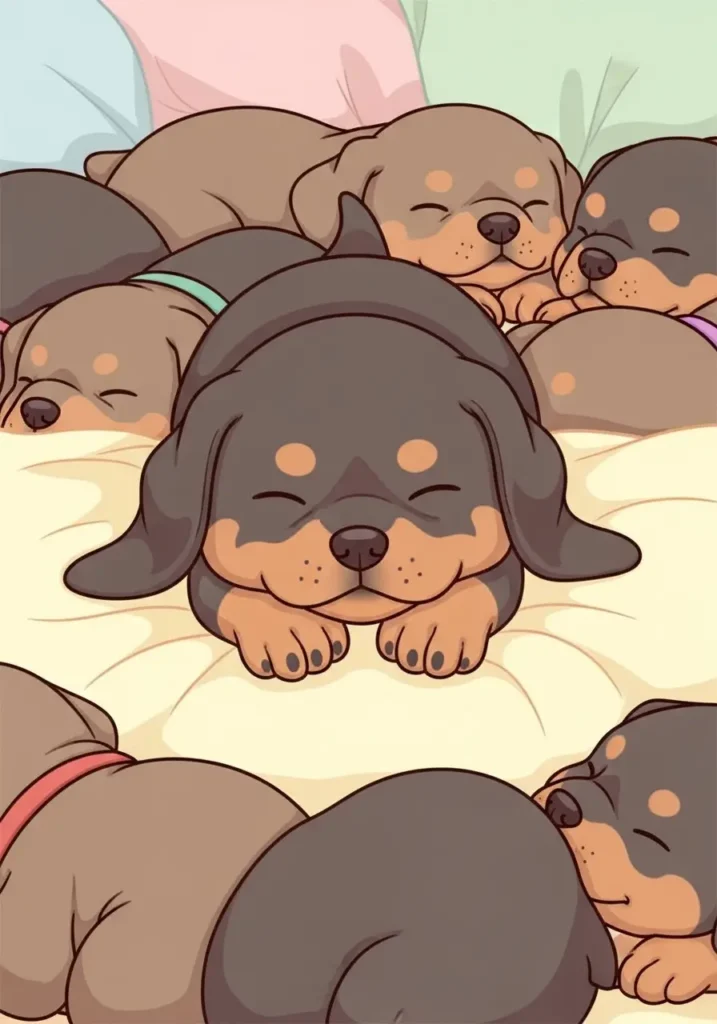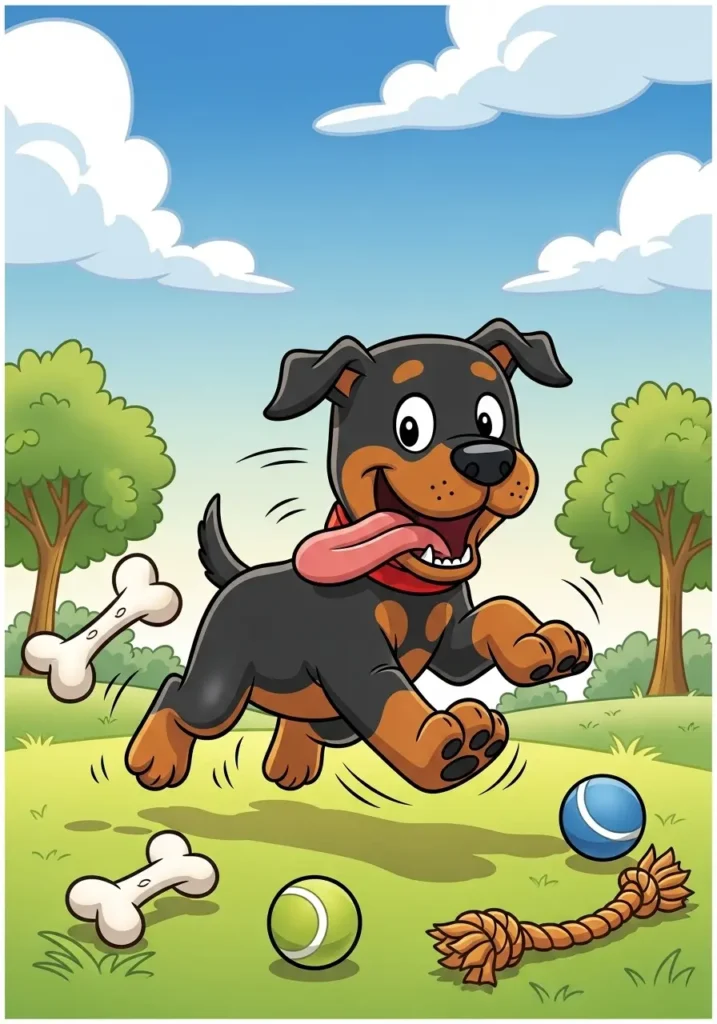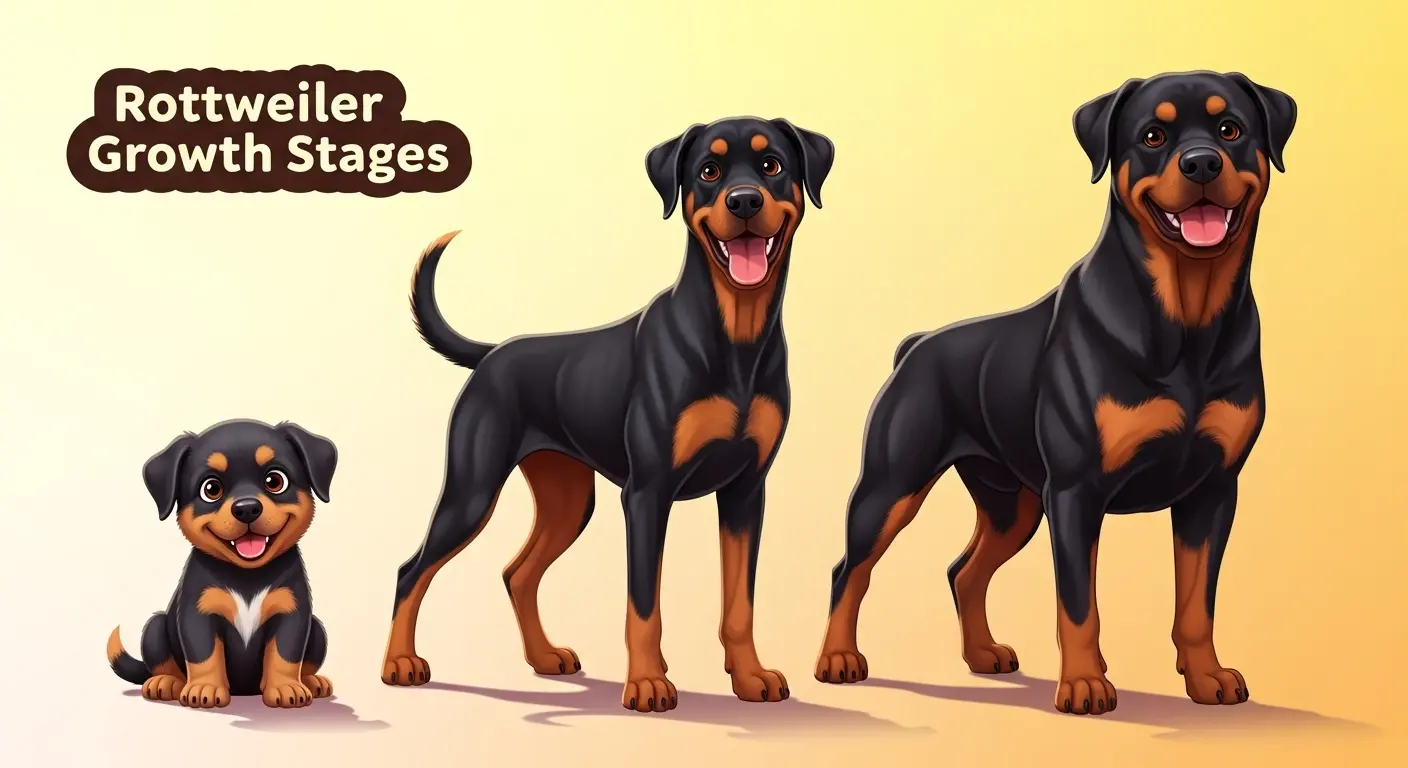Ever seen a Rottweiler puppy try to bark for the first time? It’s like a squeaky toy pretending to be a lion.
But give that same pup a few months, and suddenly you’ve got a walking tank guarding your couch. Rottie growth isn’t just fast it’s wild.
Let’s break down every stage of their transformation so you know exactly what’s happening under all that fur and attitude.
The Early Days (0–8 Weeks): The Tiny Potato Stage

You know how newborn Rottweilers look? Round, sleepy, and slightly confused about everything — kind of like tiny potatoes with tails.
At this stage, they’re completely dependent on their mom for warmth and milk. They mostly sleep, eat, and squeak (a lot). Don’t expect any growth miracles just yet, but believe me, the transformation is coming.
What to Expect:
- Weight: Around 3–6 lbs for females and 4–8 lbs for males.
- Size: So small you can literally hold them in one hand (carefully, please).
- Behavior: Sleeping 90% of the time, nursing the rest.
- Milestone: Their eyes and ears open, and they start wiggling around like clumsy worms.
Pro Tip: If you’re adopting from a breeder, don’t bring your pup home before 8 weeks. They need this time to develop social and immune skills from mom and littermates.
2–3 Months: The “Fluffy Terror” Phase

This is when your Rottie puppy starts showing personality — and chaos. They discover their bark, their teeth, and their incredible ability to chew on literally everything you own.
Average Weight:
- Males: 12–16 lbs (2 months), 34–39 lbs (3 months)
- Females: 10–14 lbs (2 months), 30–35 lbs (3 months)
Height: Around 15–18 inches at the shoulder by the end of month three.
You’ll notice they grow fast. One day they’re a fluffball that fits in your lap, the next they’re testing gravity by jumping off the couch.
Real Example:
A friend of mine once left her 10-week-old Rottie alone for 10 minutes. The puppy managed to drag an entire toilet paper roll through the house like it was a red carpet premiere. Classic.
Tip: Start training early. Rotties are smart — and stubborn. The sooner you teach them manners, the fewer destroyed shoes you’ll mourn later.
Rottweiler Dog Breed Information: Facts, Traits, Pictures & More
4–6 Months: The Growth Explosion
Welcome to the “teenager with attitude” stage. Rottweilers go through a massive growth spurt around this time. You’ll swear they grow overnight.
Average Weight:
- Males: 44–71 lbs
- Females: 35–64 lbs
Height: Around 20–23 inches.
At this stage, they’ll look big but still have that awkward, lanky puppy vibe. Think: big paws, long legs, goofy grin. Kind of like a kid who outgrew their clothes too fast.
Behavior You’ll Notice:
- Endless energy (and zoomies).
- Random clumsiness — bumping into furniture, slipping on floors, etc.
- Starting to show protective instincts but still learning control.
Pro Tip: Feed a large-breed puppy formula. Rotties need balanced nutrients to support bone growth and prevent joint issues like hip dysplasia later on. Don’t overfeed, though — chubby Rotties might look cute now, but it’s bad news for their joints long-term.
7–12 Months: The “Mini-Adult” Phase

Congrats — your pup looks like an adult Rottweiler now… sort of. They’ve filled out in the shoulders and chest, their face looks more defined, and that deep “I mean business” bark has arrived. But inside? Still very much a kid.
Average Weight:
- Males: 72–125 lbs by 1 year
- Females: 65–95 lbs by 1 year
Height: Around 22–27 inches.
Most Rottweilers reach their full height by one year old, but not their full weight. They’ll continue bulking up for another year or two.
Fun Fact: Many Rottie owners panic around 9 months because their dog’s head looks small compared to the body. Relax — it’s normal. Their broad skull and jaw muscles continue developing until around 18–24 months.
Real Example:
My own Rottie, Max, hit 100 lbs at 11 months but still looked like a gym bro skipping leg day. By age two, he finally filled out, and his head caught up. Patience is key!
1–2 Years: The “Final Form” Transformation
By now, your Rottweiler looks majestic. The muscle definition, the confident walk, the “I protect this house” stare — it’s all there.
Average Weight at Full Maturity:
- Males: 95–135 lbs
- Females: 80–100 lbs
Height: 22–27 inches (usually set by now).
But don’t let the mature appearance fool you — emotionally, they can still be goofy and playful. They’ll finally calm down around age two (give or take), which means fewer chewed-up pillows and more chill naps by your side.
Pro Tip: Keep up the vet checkups. Large breeds like Rottweilers are prone to hip dysplasia, heart issues, and joint problems. Early detection can make a world of difference.
How to Tell If Your Rottie’s Still Growing
Ever wondered if your Rottweiler is done growing or just taking a break? Here’s how you can tell:
1. Check the Paws:
If those paws still look oversized compared to the rest of the body, your pup’s still got some growing to do.
2. Look at the Chest:
Adult Rottweilers have broad, muscular chests. A narrow or “boxy” chest usually means they’re still filling out.
3. Watch Their Behavior:
Puppies are clumsy; adults move with power and purpose. If your Rottie still stumbles over its own legs, it’s still in the growth phase.
4. Ask Your Vet or Breeder:
They can estimate growth completion based on genetics, gender, and overall health.
Male vs. Female Growth: What’s the Difference?
Let’s be real — male Rottweilers are the beefier, bulkier ones. They’re like the gym enthusiasts of the dog world. Females, though slightly smaller, are often quicker, more agile, and just as protective.
Quick Comparison:
| Trait | Male Rottweiler | Female Rottweiler |
|---|---|---|
| Height | 24–27 inches | 22–25 inches |
| Weight | 95–135 lbs | 80–100 lbs |
| Personality | Confident, territorial | Alert, affectionate, steady |
| Growth Completion | Around 2–3 years | Around 2 years |
IMO, both are equally amazing. If you want a slightly calmer companion, go with a female. If you love that “gentle giant” vibe, a male might be your match. 🙂
Common Growth Mistakes Owners Make
Even experienced owners mess up sometimes (yep, been there). Here are a few things to avoid if you want your Rottie to grow strong and healthy:
1. Overfeeding:
Bigger isn’t always better. Overweight pups develop joint issues early. Stick to portion control and vet-approved diets.
2. Skipping Exercise:
Rottweilers need daily activity to stay fit and mentally balanced. Skipping walks because “it’s raining” isn’t a great excuse.
3. Poor Training:
Untrained Rotties can grow into overprotective or anxious adults. Early obedience training builds confidence and trust.
4. Ignoring Vet Visits:
Routine checkups catch problems before they become serious. Prevention > treatment every single time.
How Long Do Rottweilers Live? (Plus 7 Ways to Help Yours Live Longer)
Photos or Real Examples to Visualize Growth
While I can’t drop images here, here’s what you’d typically see through each phase:
- 8 Weeks: Tiny pup sitting in a palm, floppy ears, round belly.
- 3 Months: Fluffier coat, bigger head, curious expression.
- 6 Months: Slim and tall, long legs, awkward stance.
- 1 Year: Muscular build forming, shiny black coat, broad shoulders.
- 2 Years: Fully mature — confident stance, thick neck, majestic look that screams “Rottweiler royalty.”
Trust me, comparing photos month by month is wild. You’ll barely recognize your dog after a year!
How to Support Healthy Growth
Here’s how to make sure your Rottie grows into that strong, healthy adult you dreamed of:
1. Nutrition:
Feed large-breed puppy food with controlled calcium and phosphorus. Avoid overfeeding — it stresses growing joints.
2. Exercise:
Moderate play and walks are great. Avoid heavy running or jumping on hard surfaces during growth months to protect their joints.
3. Training and Socialization:
Introduce your pup to new people, pets, and environments early. A well-socialized Rottweiler is calm, confident, and friendly.
4. Regular Vet Checkups:
Schedule x-rays or joint screenings if your vet recommends them. Catching hip or elbow issues early saves a lot of trouble later.
5. Love and Patience:
Yeah, I know — it sounds cheesy. But Rottweilers thrive on connection. Treat them like family, and they’ll return that loyalty tenfold.
FAQs About Rottweiler Growth
Q: When do Rottweilers stop growing?
Most stop around two years, though some males fill out until age three.
Q: My Rottie looks skinny — should I worry?
Not necessarily. Puppies go through lanky phases. Check with your vet before adjusting diet.
Q: Are bigger Rottweilers better?
Nope. Balanced and strong is healthier than bulky and heavy. Oversized Rotties are more prone to health problems.
Q: Can I tell adult size from the parents?
Yes! Puppies rarely outgrow their biggest parent. Ask your breeder for parent weights as a guideline.
Final Thoughts
Watching a Rottweiler grow is nothing short of amazing. From that tiny, sleepy pup to the confident protector strutting beside you — every stage feels special (and occasionally chaotic).
If there’s one takeaway, it’s this: be patient. Rottweilers take their sweet time growing into their full potential. Feed them right, train them well, and give them the love they deserve. The result? A loyal, powerful companion who’ll stand by your side for years.
And when you finally look at that full-grown Rottie and remember the days they fit in your arms — yeah, that’s the best feeling ever. ❤️
